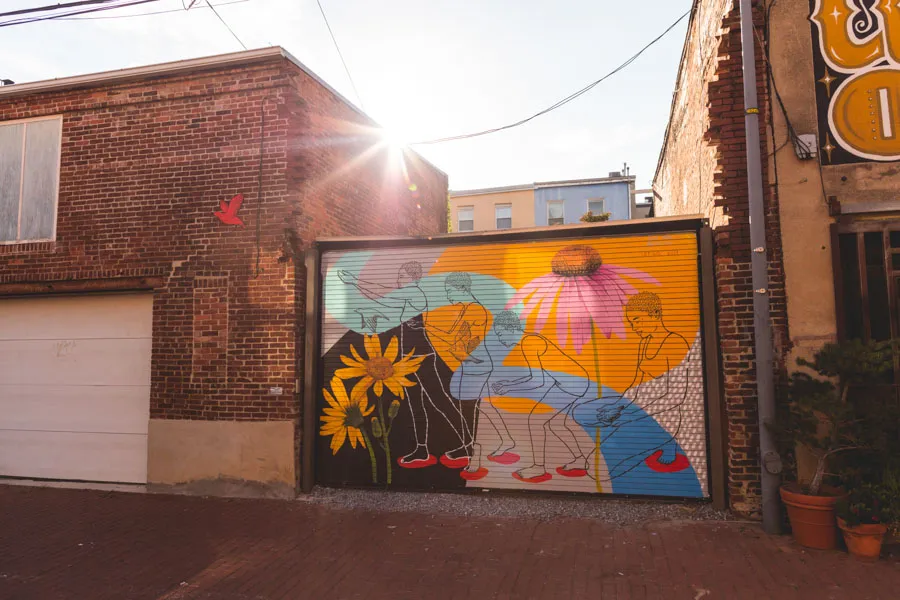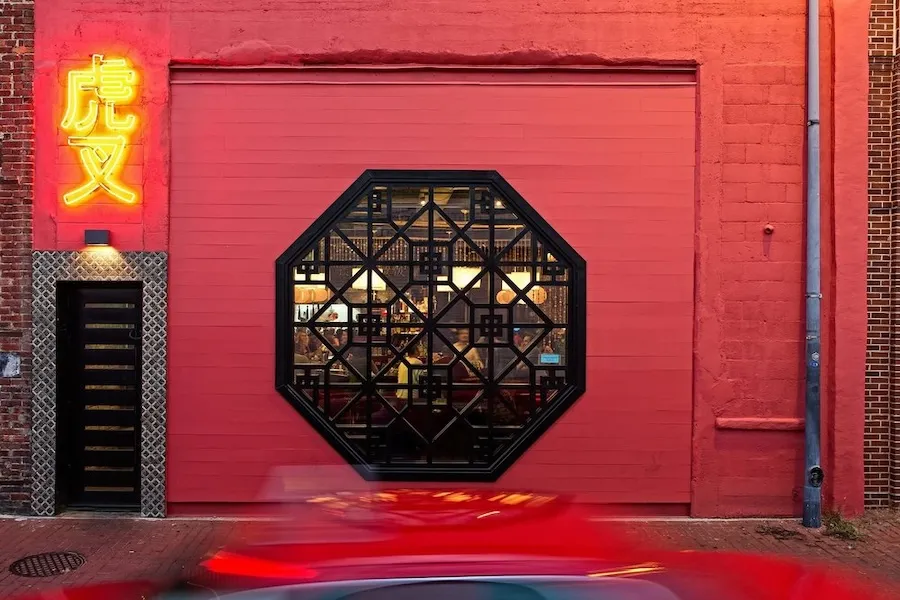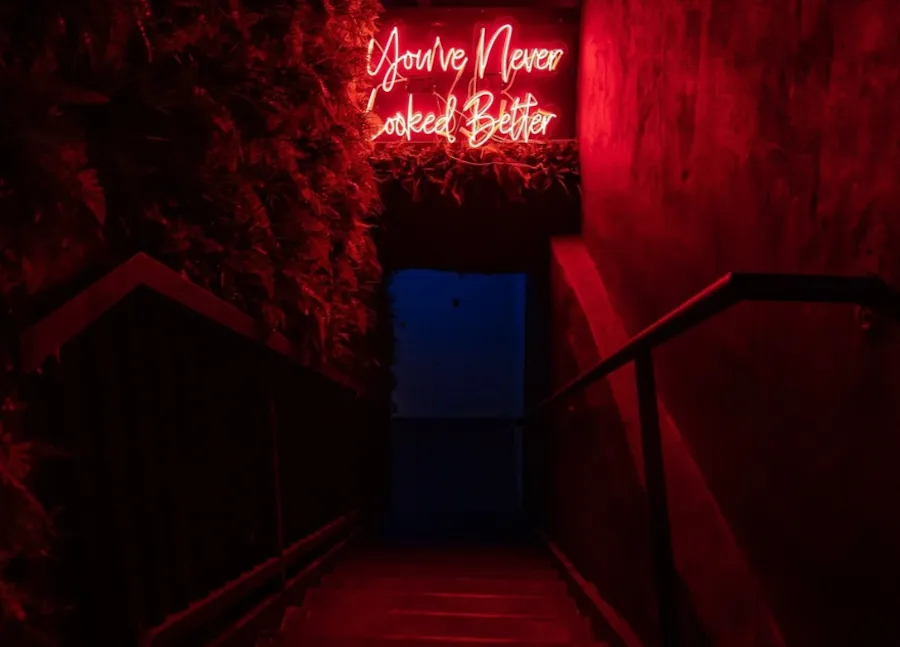Washington D.C., the dazzling capital of the United States, is renowned not only for its majestic monuments and magnificent museums. Hidden within the bustling city are charming historic neighborhoods where time seems to slow down and life becomes more peaceful. Narrow lanes, cobblestone streets, and historic houses tell unique stories of history and culture, offering visitors vivid and authentic experiences like never before. Let’s explore these hidden gems with “Du lịch khắp thế gian” (Travel the World), where you can feel the heartbeat of Washington D.C. in a completely different way.
Shaw Neighborhood and Blagden Alley & Naylor Court
Nestled in the vibrant Shaw neighborhood, Blagden Alley and Naylor Court are like a peaceful oasis, where street art and unique cuisine blend together. Recognized as a historic district by the National Park Service, these alleys were once home to working-class communities and African Americans, and have now transformed into an attractive destination, captivating visitors with their creativity and strong community spirit.
Blagden Alley, with its photogenic beauty and trendy style, is home to the DC Alley Museum, an impressive collection of colorful murals. These artworks, painted on garage doors and building walls, not only beautify the space but also tell stories about the local history, culture, and people. Among them, the LOVE mural by Lisa Marie Thalhammer stands out, a work that celebrates love and diversity, along with mosaics honoring immigrants and Black families who were once connected to this neighborhood.

Beyond the street art scene, Blagden Alley is also a culinary paradise with unique restaurants and cafes. Refurbished carriage houses have become ideal locations for memorable dining experiences. La Colombe, the District’s first coffee roaster, retains many original architectural features, offering a historically rich coffee experience. Dabney, a restaurant famous for its wood-fired Mid-Atlantic cuisine, brings a warm and traditional flavor. Causa/Amazonia, with its award-winning Peruvian dishes and rooftop bar, is the perfect destination for those wanting to explore South American flavors. And don’t forget Tiger Fork, a Hong Kong-style bar where you can enjoy unique cocktails in an Asian-inspired setting.
To discover hidden secrets, head to Never Looked Better, a secret and charming basement cocktail bar. To get there, you’ll have to go through a loading dock and kitchen, creating a journey of unexpected discovery. If you’re looking for a green and quiet space, Calico, with its secluded garden and vintage greenhouse, is an excellent choice.

Not far from Blagden Alley is Naylor Court, a smaller U-shaped alley where architects’ studios and private residences stand side by side. Look out for traces of EJ Adams & Co. Stables, a historic stable facility, and don’t forget to visit Sundevich, a famous sandwich shop with a diverse menu that takes you to a different city in the world with just one bite.

Experiencing life in Blagden Alley and Naylor Court is not just about exploring art and food, but also immersing yourself in the vibrant community atmosphere and feeling the transformation of a historic neighborhood. Take time to stroll through these alleys, discover hidden corners, and enjoy the unique experiences that this place offers.
Georgetown Neighborhood and Cady’s Alley & Blues Alley
If Blagden Alley and Naylor Court attract foodies and art lovers, then Cady’s Alley and Blues Alley in Georgetown are ideal destinations for those passionate about design and appreciate sophistication. Georgetown, one of Washington D.C.’s oldest and most luxurious neighborhoods, is famous for its historic architecture, high-end boutiques, and elegant atmosphere.
Cady’s Alley, with its brick and cobblestone streets, is the heart of the Georgetown Design District. It is home to over 20 showrooms and design stores for interior decor, fashion, jewelry, and antiques. These spaces are located in old industrial buildings, creating a unique blend of classic and modern styles. You can find world-renowned brands and unique local brands like Scout Bags, famous for its fashionable and practical handbags.

After indulging in shopping and admiring unique designs, Cady’s Alley also offers many dining options for you to relax and enjoy. Kyōjin, a modern sushi restaurant, offers a high-end Japanese dining experience with a special tasting menu. If you’re looking for a quaint and cozy space, Kafe Leopold is the perfect choice. This European-style cafe serves Austrian specialty coffees and light meals, creating an ideal space for you to relax and watch people go by. Cady’s Alley is easily accessible from M Street NW or from M Street and 33rd or 34th Streets.
Blues Alley, located nearby, offers a completely different atmosphere. This alley is quieter and less crowded than Cady’s Alley, but it is home to an iconic Georgetown landmark: Blues Alley Jazz Club. This legendary jazz club has hosted countless world-famous artists and is a must-visit destination for jazz lovers.

Another special feature of Blues Alley is Hinckley Pottery, a locally owned and operated pottery studio and shop. Located in a 125-year-old stable, Hinckley Pottery offers unique handmade pottery, reflecting the creative spirit and tradition of Georgetown.
Before leaving this area, visit The Sovereign, a Belgian beer bar hidden in a small alley next to Abercrombie and Fitch, just before you reach the bustling intersection of Wisconsin and M. Enjoying a delicious Belgian beer in the bar’s cozy atmosphere is a great way to end your exploration of historic Georgetown.
Capitol Hill Neighborhood and Library Court NE+
Capitol Hill, home to the Capitol Building and the Library of Congress, is not only famous for its grand architecture but also hides historic alleys steeped in time. Library Court NE+, located between 3rd and 4th Streets NE, is one of the narrowest and most notable residential alleys in the area.
These alleys, planned by Pierre L’Enfant in the original plan of Washington D.C., were initially designed as discreet entrances for working-class people to serve in the homes of wealthy families. Today, they have become quiet and charming streets, offering a unique perspective on everyday life in the heart of the capital.

Library Court, Millers Court, and Frederick Douglas Court follow each other, creating a chain of narrow alleys, just wide enough for a car and rows of green trees reminiscent of a quiet lane. The residential houses along these alleys offer a cozy and intimate feeling, completely different from the hustle and bustle of the main streets.
Walking through Library Court NE+, you will feel a rare peace and tranquility in the heart of the city. Slow down your steps, admire the historic houses, and feel the slow pace of life in the neighborhood. Sometimes, you may encounter a street with a prominent status, a historical mark preserved in the modern city.
NoMa/Union Market Neighborhood and Morse Street Alley
The NoMa and Union Market neighborhood, a rapidly developing area in Washington D.C., hides an easily overlooked gem: Morse Street Alley. Located between 4th and 5th Streets NE, this alley is part of a 200-year-old neighborhood that was once the city’s bustling wholesale center.
At first glance, Morse Street Alley may seem unremarkable, just back entrances, garage doors, and graffiti-covered walls. However, upon closer inspection, you will see a white curved arrow painted on brick, pointing to Bread Alley, a famous bakery hidden inside.

Bread Alley is not just an ordinary bakery. It is famous for its high-quality, handcrafted breads made using traditional methods. Bread from Bread Alley is served at Le Diplomate, a famous French restaurant in Washington D.C., proving the quality and reputation of this bakery.
Exploring Morse Street Alley, you will not only find Bread Alley but also discover other shops and creative spaces that are gradually forming in this area. The combination of the antiquity of the historic neighborhood and the dynamism of the developing area creates a unique and attractive atmosphere.
Wharf Neighborhood and Pearl Street
The Wharf neighborhood, a newly developed waterfront area in Washington D.C., offers a vibrant and modern space. While most of the alleys in The Wharf are pedestrian-only, Pearl Street evokes the hidden feel of D.C.’s most luxurious alleys, but with a completely new style.
In the evening, Pearl Street becomes sparkling and bustling with string lights crisscrossing overhead, outdoor tables spilling onto the street, and music emanating from entertainment venues. It is home to many restaurants and bars, creating an ideal space for dining and nightlife.

Pearl Street Warehouse and Union Stage are two famous music venues located on Pearl Street, regularly hosting live performances, attracting large audiences. You can enjoy live music in the outdoor space or in cozy bars.
Colada Shop, a Cuban cafe, is an ideal destination for you to enjoy Cuban sandwiches and delicious cocktails. The shop has folding tables and a covered patio, creating a comfortable space for you to relax and watch people go by.
Pearl Street is not just an ordinary pedestrian street, but a vibrant living experience space where you can immerse yourself in the bustling atmosphere of The Wharf, enjoy diverse cuisine, and enjoy great music.
Conclusion
The historic neighborhoods and alleys of Washington D.C. are not just tourist destinations, but also vibrant living spaces where you can experience local culture, history, and cuisine in the most authentic way. From the artistic creativity of Blagden Alley to the design beauty of Cady’s Alley, from the tranquility of Library Court NE+ to the vibrancy of Pearl Street, each alley offers a unique and memorable experience.
Take time to explore these hidden gems on your Washington D.C. trip. You will not only discover beautiful places, but also feel the rhythm of life and spirit of the city in a completely different way. Living experiences in the historic alleys of Washington D.C. will surely be memorable and profound memories in your heart.